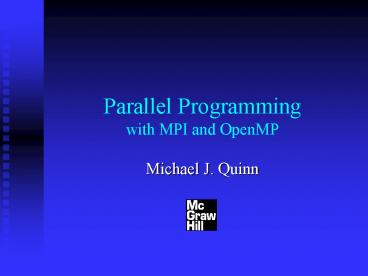Parallel Programming with MPI and OpenMP - PowerPoint PPT Presentation
1 / 33
Title:
Parallel Programming with MPI and OpenMP
Description:
Parallel Programming with MPI and OpenMP Michael J. Quinn Chapter 6 Floyd s Algorithm Chapter Objectives Creating 2-D arrays Thinking about grain size ... – PowerPoint PPT presentation
Number of Views:136
Avg rating:3.0/5.0
Title: Parallel Programming with MPI and OpenMP
1
Parallel Programmingwith MPI and OpenMP
- Michael J. Quinn
2
Chapter 6
- Floyds Algorithm
3
Chapter Objectives
- Creating 2-D arrays
- Thinking about grain size
- Introducing point-to-point communications
- Reading and printing 2-D matrices
- Analyzing performance when computations and
communications overlap
4
Outline
- All-pairs shortest path problem
- Dynamic 2-D arrays
- Parallel algorithm design
- Point-to-point communication
- Block row matrix I/O
- Analysis and benchmarking
5
All-pairs Shortest Path Problem
4
A
B
6
3
1
3
5
C
1
D
2
E
6
Floyds Algorithm
for k ? 0 to n-1 for i ? 0 to n-1 for j ? 0 to
n-1 ai,j ? min (ai,j, ai,k
ak,j) endfor endfor endfor
7
Why It Works
Shortest path from i to k through 0, 1, ,
k-1
i
k
Shortest path from i to j through 0, 1, ,
k-1
Shortest path from k to j through 0, 1, ,
k-1
j
8
Dynamic 1-D Array Creation
Run-time Stack
Heap
9
Dynamic 2-D Array Creation
Run-time Stack
Bstorage
B
Heap
10
Designing Parallel Algorithm
- Partitioning
- Communication
- Agglomeration and Mapping
11
Partitioning
- Domain or functional decomposition?
- Look at pseudocode
- Same assignment statement executed n3 times
- No functional parallelism
- Domain decomposition divide matrix A into its n2
elements
12
Communication
Updating a3,4 when k 1
Primitive tasks
Iteration k every task in row k broadcasts its
value w/in task column
Iteration k every task in column
k broadcasts its value w/in task row
13
Agglomeration and Mapping
- Number of tasks static
- Communication among tasks structured
- Computation time per task constant
- Strategy
- Agglomerate tasks to minimize communication
- Create one task per MPI process
14
Two Data Decompositions
Rowwise block striped
Columnwise block striped
15
Comparing Decompositions
- Columnwise block striped
- Broadcast within columns eliminated
- Rowwise block striped
- Broadcast within rows eliminated
- Reading matrix from file simpler
- Choose rowwise block striped decomposition
16
File Input
17
Pop Quiz
Why dont we input the entire file at once and
then scatter its contents among the processes,
allowing concurrent message passing?
18
Point-to-point Communication
- Involves a pair of processes
- One process sends a message
- Other process receives the message
19
Send/Receive Not Collective
20
Function MPI_Send
int MPI_Send ( void message,
int count, MPI_Datatype
datatype, int dest, int
tag, MPI_Comm comm )
21
Function MPI_Recv
int MPI_Recv ( void message,
int count, MPI_Datatype
datatype, int source, int
tag, MPI_Comm comm,
MPI_Status status )
22
Coding Send/Receive
if (ID j) Receive from I
if (ID i) Send to j
Receive is before Send. Why does this work?
23
Inside MPI_Send and MPI_Recv
Sending Process
Receiving Process
Program Memory
System Buffer
System Buffer
Program Memory
24
Return from MPI_Send
- Function blocks until message buffer free
- Message buffer is free when
- Message copied to system buffer, or
- Message transmitted
- Typical scenario
- Message copied to system buffer
- Transmission overlaps computation
25
Return from MPI_Recv
- Function blocks until message in buffer
- If message never arrives, function never returns
26
Deadlock
- Deadlock process waiting for a condition that
will never become true - Easy to write send/receive code that deadlocks
- Two processes both receive before send
- Send tag doesnt match receive tag
- Process sends message to wrong destination process
27
Computational Complexity
- Innermost loop has complexity ?(n)
- Middle loop executed at most ?n/p? times
- Outer loop executed n times
- Overall complexity ?(n3/p)
28
Communication Complexity
- No communication in inner loop
- No communication in middle loop
- Broadcast in outer loop complexity is ?(n log
p) - Overall complexity ?(n2 log p)
29
Execution Time Expression (1)
30
Computation/communication Overlap
31
Execution Time Expression (2)
32
Predicted vs. Actual Performance
Execution Time (sec) Execution Time (sec)
Processes Predicted Actual
1 25.54 25.54
2 13.02 13.89
3 9.01 9.60
4 6.89 7.29
5 5.86 5.99
6 5.01 5.16
7 4.40 4.50
8 3.94 3.98
33
Summary
- Two matrix decompositions
- Rowwise block striped
- Columnwise block striped
- Blocking send/receive functions
- MPI_Send
- MPI_Recv
- Overlapping communications with computations































